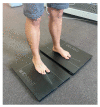Comparison between Exercise Program-Foot Orthoses Treatment and Exercise Program Alone after Pilon Fracture Surgery: Study Protocol for a Randomized Controlled Trial
- PMID: 38004327
- PMCID: PMC10672240
- DOI: 10.3390/life13112187
Comparison between Exercise Program-Foot Orthoses Treatment and Exercise Program Alone after Pilon Fracture Surgery: Study Protocol for a Randomized Controlled Trial
Abstract
The management of tibial pilon fractures is challenging and often leads to complications and limitations in ankle function. The study aims to investigate myotonometric parameters and muscle strength of ankle muscles, as well as gait pattern and balance among patients following surgical treatment of pilon fractures. The randomized controlled study will analyze the differences between the patients who will follow a 3-month physical exercise program and will wear customized foot orthoses (i.e., customized orthotic arch support insoles) versus patients who will attend only the physical exercise program. For each group, at least 21 patients will be required. The assessment involves four different testing procedures: myotonometry (anterior tibialis, medial and lateral gastrocnemius, and longus peroneus assessed using MyotonPRO), muscle strength testing (ankle dorsiflexors, plantar flexors, and peroneal muscles assessed using MicroFET2 dynamometer), analysis of gait parameters (using Scheinworks treadmill), and double-leg and single-leg balance tests (using K-Force plate). After 3 months, the assessments will record which of the two treatments (physical exercise program with or without wearing customized foot orthoses) has better outcomes in regaining ankle muscle properties and tone, as well as the restoration of gait and balance.
Keywords: balance; foot orthoses; gait analysis; muscle strength; myotonometry; pilon fracture.
Conflict of interest statement
The authors declare no conflict of interest.
Figures




Similar articles
-
The influence of insoles with a peroneal pressure point on the electromyographic activity of tibialis anterior and peroneus longus during gait.J Foot Ankle Res. 2016 Aug 22;9(1):33. doi: 10.1186/s13047-016-0162-5. eCollection 2016. J Foot Ankle Res. 2016. PMID: 27555883 Free PMC article. Clinical Trial.
-
Effects of wearing foot orthosis with medial arch support on the fifth metatarsal loading and ankle inversion angle in selected basketball tasks.J Orthop Sports Phys Ther. 2007 Apr;37(4):186-91. doi: 10.2519/jospt.2007.2327. J Orthop Sports Phys Ther. 2007. PMID: 17469671
-
Muscle activity in children with spastic unilateral cerebral palsy when walking with ankle-foot orthoses: an explorative study.Gait Posture. 2020 Jul;80:31-36. doi: 10.1016/j.gaitpost.2020.05.011. Epub 2020 May 23. Gait Posture. 2020. PMID: 32485421
-
Contributions to the understanding of gait control.Dan Med J. 2014 Apr;61(4):B4823. Dan Med J. 2014. PMID: 24814597 Review.
-
Orthotic treatment for stage I and II posterior tibial tendon dysfunction (flat foot): A systematic review.Clin Rehabil. 2021 Feb;35(2):159-168. doi: 10.1177/0269215520960121. Epub 2020 Oct 11. Clin Rehabil. 2021. PMID: 33040609
Cited by
-
Transforming the Management of Articular Fractures in the Foot: A Critical Examination of Current Methods and Future Directions: A Review.J Pers Med. 2024 May 15;14(5):525. doi: 10.3390/jpm14050525. J Pers Med. 2024. PMID: 38793107 Free PMC article. Review.
References
-
- Mauffrey C., Vasario G., Battiston B., Lewis C., Beazley J., Seligson D. Tibial pilon fractures: A review of incidence, diagnosis, treatment, and complications. Acta Orthop. Belg. 2011;77:432–440. - PubMed
LinkOut - more resources
Full Text Sources

